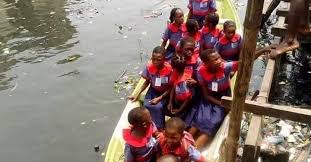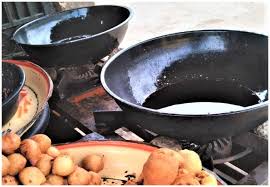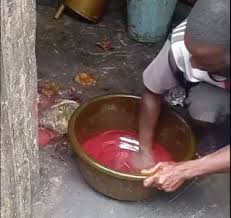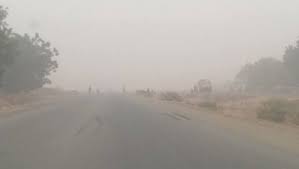
Floodwaters force Makoko children out of school amid disease fears
Our correspondent visited Samson's mother's little shop with Oluwatobi Aide, the founder of Enayon Makoko Children Foundation School and Orphanage Home.
He bemoaned the fact that, particularly during the intense rains, other kids in the neighborhood had sustained injuries akin to Samson's.
According to Aide, when it rains a lot, flooding carry rubbish into Makoko, such as sharp objects, shattered bottles, and other hazardous waste.
He claims that because the hamlet is situated just before the lagoon on the borders of the mainland Lagos, it serves as a gathering place for a variety of hazardous chemicals that are transported from other areas of the city.
He pointed out that the children's surroundings is exceedingly unsafe due to this hazardous mixture of waste and toxins, endangering their health and well-being.
Rain is more than just bad weather for many kids in Makoko, which is frequently referred to as Africa's greatest slum; it is a significant barrier to their future, education, and health.Samson, twelve, is sitting calmly on a low wooden stool outside his cramped, tiny Makoko home. His eyes are tired and his face is pale. As he attempts to write in his notebook, his leg, which is bandaged with scratchy material, trembles a little. Under the overcast sky, his mother stands next to him, selling fish while casting anxious glances at her son, who has been too ill to go back to school this week.
Samson will always remember July 4, 2025. The rain fell more heavily than usual, transforming Makoko's winding wooden streets into muddy, filthy rivers.
Samson will always remember July 4, 2025. The rain fell more heavily than usual, transforming Makoko's winding wooden streets into muddy, filthy rivers. As floodwaters began to seep into classrooms, Samson's school, Enayon Makoko Children Foundation School and Orphanage Home, was forced to send the kids home early. However, the return trip was anything but secure.
Samson was knee-deep in water as he waded through the flooded streets, oblivious to the jagged edge of a shattered bottle beneath the murky water. He felt a searing pain as the bottle sliced deep into his calf. His injury rapidly worsened, but he was treated at home because there was no hospital close by and there was not much money.
By Tuesday, Samson was still having trouble walking and was writing slowly while threatening to cry out in agony.
Our correspondent visited Samson's mother's little shop with Oluwatobi Aide, the founder of Enayon Makoko Children Foundation School and Orphanage Home.
He bemoaned the fact that, particularly during the intense rains, other kids in the neighborhood had sustained injuries akin to Samson's.
According to Aide, when it rains a lot, flooding carry rubbish into Makoko, such as sharp objects, shattered bottles, and other hazardous waste.
He claims that because the hamlet is situated just before the lagoon on the borders of the mainland Lagos, it serves as a gathering place for a variety of hazardous chemicals that are transported from other areas of the city.
He pointed out that this hazardous combination of garbage and pollution makes the environment extremely unsafe for the children, putting their health and safety at great risk.
Rain is more than just bad weather for many kids in Makoko, which is frequently referred to as Africa's greatest slum; it is a significant barrier to their future, education, and health.
Schools in the flooded town move quickly to either locate safer areas to hide the children or send them home in a hurry to prevent danger whenever dark clouds build up and the heavens threaten to open.
Floodwaters swiftly rise, engulfing streets, sidewalks, and classrooms, leaving kids stranded and unable to finish their education, it was learned.
Every rainy season, many kids are forced to miss days or even weeks of classes because the rising water blocks entrance to schools.
Our correspondent's research showed that frequent flooding not only interferes with education but also fosters an environment that is vulnerable to injuries and diseases.
Already beset by a lack of resources, schools get wet, moldy, and dangerous. Numerous classrooms become havens for illnesses including cholera, malaria, and skin infections, endangering the health of kids.
After a strong downpour, it is filthy.
Our correspondent visited the hamlet on Tuesday, just twenty-four hours after a torrential downpour blasted over nearly every area of Lagos. However, the rain at Makoko did more than just fall; it turned the slum into a roiling mashup of filth, mud, and foul odor.
The air smelled of deterioration as soon as our correspondent entered Makoko. A sickening mixture of stagnant water, decaying waste, and human feces filled the air, along with a strong stench. The aftermath of the downpour overtook the stilt-supported riverine portions and the sand-filled mainland portion of the community.
Sharp objects, rotten food, plastic bags, and human waste drifted over the tiny sidewalks, collecting in choked drains and murky puddles.
The gutters, which are the only drainage system in most of Makoko, were clogged with broken bottles, dead rats, discarded nylon bags, and layers of black muck.
Some gutters were seen to have overflowed into the small alleys, filling houses and businesses with stench-filled water.
Residents had to walk through water that was ankle or knee deep and tainted with trash and excrement in some places where temporary wooden bridges had been washed away.
Unaware of the harmful bacteria hiding beneath, our correspondent observed kids playing barefoot on the rims of these pools.
Watermarks on the walls of a number of houses showed how high the river had climbed the previous day.
The temporary educational institutions
Our correspondence visited two of Makoko's main community-run primary schools: Potential Children School, which is deep within the riverine, stilt-based section of the community, and Enayon Makoko Children Foundation School and Orphanage Home, which is located on the sand-filled section of the slum.
The homeowners who own and run both schools are committed to providing education to kids who would otherwise be left behind. However, what our correspondent saw revealed the harsh realities they face in that mission.
Built nearly entirely of wood, aluminum sheets, and other repurposed materials, the schools are essentially homemade. Each was constructed as a two-story building that was raised to try to keep classrooms above flood levels. However, the power of nature frequently surpasses even this ingenuity.
The effects of the most recent rainstorm are evident as soon as one enters the grounds of these institutions.
Mud, plastic debris, and decomposing stuff were mingled with stagnant, murky water surrounding the ground floors of both buildings. The air was heavy with the smell of damp trash.
Students were observed making their way to class at Enayon Makoko Children Foundation School and Orphanage Home while avoiding odorous water pools. Teachers were forced to either transfer their courses upstairs or cancel them completely because the entrances to certain classrooms were partially inundated.
Rain seeped through badly patched roofs, leaving the wooden floors inside still damp. Watermarks and mold were visible on the walls, and the corners of a few rooms had darkened due to rot and moisture buildup.
The school's founder, Oluwatobi Aide, stated that they prepare for any disruptions whenever it rains.
"The first thing we do when the rain starts is send the kids home because the water comes quickly and floods the whole place," he said.
Sometimes the ground floor is gone before we can even react. For their safety, the children must either go home or relocate to the top level.
Although the school represents resiliency, our correspondent noted that it also highlights the extent to which these kids are exposed to environmental risks.
The whole area surrounding the school was flooded after the storm.
Additionally, trashed food wrappers, nylon bags, and empty plastic bottles were seen floating around the stilts supporting the building. Water was all over the place, with no obvious boundary between the lagoon and the school grounds.
Notwithstanding these difficulties, research revealed that the two schools together provide more than 600 kids with education, food, care, and occasionally housing, making them lifelines.
Additionally, our correspondent noted that most of the kids were wearing slippers, rubber shoes, or shoes without laces, which raises the possibility of infections.
Fighting off illnesses
Many of the kids who go to school in Makoko face an unseen risk of contracting diseases that flourish in the filthy, flood-ravaged environment. Their health suffers greatly as a result, frequently depriving them of their strength and dignity in addition to classroom time.
The results showed that during Makoko's rainy season, epidemics of common airborne and waterborne diseases, typhoid, skin rashes, malaria, and respiratory infections increase significantly.
Due to their exposed walls, moist interiors, and inadequate ventilation, schools unintentionally serve as breeding grounds for disease.
The problem is made worse by the lack of basic medical fa





